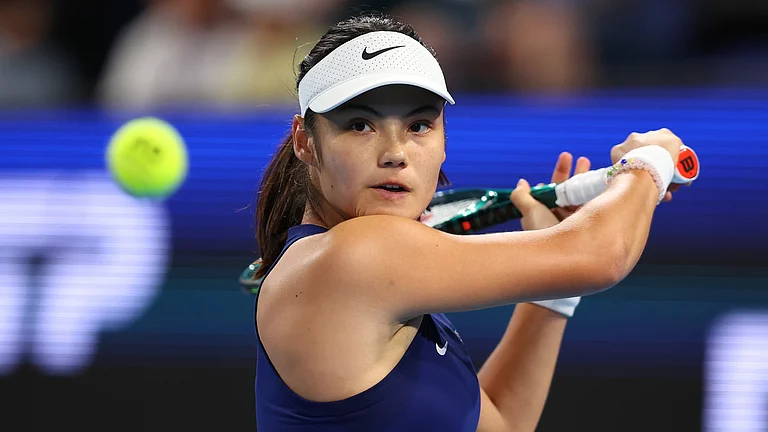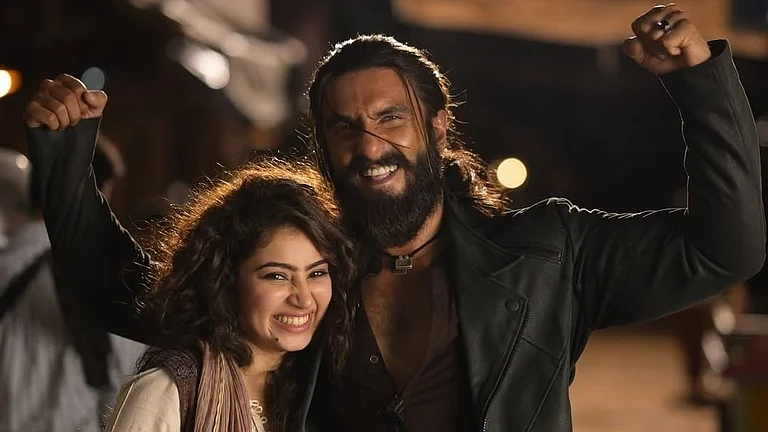I reached Gadiras late afternoon on November 6—a day before the first phase of the elections—cutting through the once-forbidden picturesque Katekalyan road from Tirathgarh. Beyond Katekalyan, the 60-km long-winding forest road gave way to a narrow forest path. Old roads dug up by Naxalites, as remarked by a passerby, were visible, marking their erstwhile presence in the region. The two-foot wide ditches were partially levelled with bamboo for two-wheelers to pass; in some places, parts of the road were padded with stones and mud, all of which still made a telling signal of a “no-go” passage for larger four-wheel vehicles.
Twenty-five-odd kilometres further from Gadiras lies Gufdi, a village considered ‘notorious’ for Naxal support. The road disappeared after a 5 km ride leading to Kondre. The rest of the 12-odd km was through a forested stretch until Gufdi.
At a dilapidated panchayat bhavan sat Manju Kawasi, the Sarpanch of Gufdi Gram Panchayat, busy discussing with young village boys the modus operandi for the 420 voters from her village to reach Kondre to cast their votes.
“The voters from our village are eager to vote, but the Election Commission has shifted the polling booth to Kondre, a good 11 km from here,” she says exasperatedly. “We have to now arrange for tractors for voters to reach the Kondre polling booth.”
People from six villages—Maroki, Gufdi, Gondpalli, Gonderas, Dabba and Pandupara (Kundanpal-2)—had petitioned the Election Commissioner as early as September 28, seeking the establishment of polling stations in their villages. However, there was no response, and instead, polling stations were shifted to locations as far as 5-20 km away.
Late into the evening on November 6, bikes could be heard moving in the area. Groups of young men were huddled together in a heated discussion. We could hear worried conversations over the phone; the now pouring rain was spoiling it further. Villagers from Pordem had to climb down the mountain—at least 15 km—to reach the polling station in Nangalguda, close to the Mankapal security camp. Gufdi was earlier with the Pordem Gram Panchayat, but was separated as a Gram Panchayat much later.
It had rained unusually that evening, leaving the villagers worried about the harvested paddy lying bundled in their farms. Could bikes ferry some of the voters through the slushy forested path? Would tractors reach on time to transport the voters, especially the elderly? The young boys were given instructions to send messages to all the houses to reach the Panchayat Bhavan by 7 AM the next morning—the election day—to be ferried to the polling booth in Kondre. But what continued to worry the Sarpanch was how to take all the 400 voters over 12 km to Kondre.

Polling in ‘Sensitive Areas’
In the first phase of elections in the state on November 7, when 20 assembly constituencies polled, 5,304 polling stations were established. Of these, 83 were considered ‘vulnerable’ and 417 ‘critical’—in other words, close to 10 per cent of the polling booths were regarded as ‘sensitive’.
In the Bastar division, over 600 polling stations were given security cover, while 149 polling stations in the five assembly constituencies of Bijapur, Narayanpur, Antagarh, Dantewada and Konta were shifted closer to the police stations and security camps for security reasons.
Sukma district’s Konta assembly constituency has 254 polling stations, 233 of which are considered sensitive. Of these, 36 polling booths were shifted, as compared to the previous year’s 40. This year, 20 polling stations were added, informs Kiran Chavan, the superintendent of police of Sukma district. When asked as to how he considered the request made by the villagers to establish polling stations in the villages, Chavan was dismissive. These are politically motivated, he says, adding that unnecessary risks could not be taken. The district has over 60 security camps.
Voting, Despite ‘Election Boycott’
Throughout the 13 km route to Gufdi, the election mood was tangible. For 5 kilometres until Kondre, large banners of political parties, primarily the Congress’ sitting MLA, Kawasi Lakma, and the CPI’s candidate, Manish Kunjam, were hung every 500 meters. Of course, the familiar hammer and sickle symbol of the CPI was replaced with an air-conditioner, due to an alleged delay in the submission of the application to secure the party symbol.
As the road thinned into a forest path, the Congress’ banners and posters became less visible. Kunjam’s face next to the new symbol is what guided the people through the forest path.
The BJP’s Konta candidate, Soyam Muka’s, banner was visibly missing. Muka was infamous for his role during Salwa Judum that had left several villages in south Bastar severely scarred.
The Maoists had, as “in practice”, called for an election boycott weeks before the election. “Chase away the Brahminical Hindutva Fascist RSS-BJP; discipline Chief Minister Bhupesh Baghel for rolling out the policies of Narendra Modi; boycott the fake assembly elections; and, strengthen the alternative Revolutionary People’s Government,” is how the two-page long Maoist note began.
Do such calls for boycott instil fear among the people? “Earlier, we were scared, but now we are not,” says Kawasi Bheema, who last voted in the 2008 assembly elections. The polling booth was then in Peshalpara in Gufdi village, he says, adding that by late afternoon, the Maoists had swooped in to take away the ballot boxes, causing panic among those on duty, he laughs.
But that was 15 years ago, he adds. Today, the villagers are ready to come out of the shadows and vote for their leader. “There are security camps all around us, so why then are we made to walk 12 km to cast our votes?” he asks. “What is the purpose of these camps? Is it not to ensure good governance, and, at least in this case, ensure an unhindered election?”
Perhaps it is better for some leaders that voters from the interior villages find it difficult to reach the polling station, says a young man standing next to Kawasi, hinting at the five-time sitting Congress MLA, Kawasi Lakma. “But we will vote this time, and we will vote for change,” says a determined Kawasi.
Changes On The Anvil?
“Look at these young boys and girls, all educated till 10th or 12th standard, and some are even attending college. But there are no jobs,” says the Sarpanch. One of the most upsetting issues shared by many in Sukma was the sidelining of Adivasis from the region for government jobs. “The current government’s promise of giving jobs to the local people remains unfulfilled,” says Jyoti Sodi, one of the Anganwadi workers. Sodi, after higher secondary, is pursuing her graduation. Her other friend, Anju Vetti, is in her final year, but does not know what the future holds.
Sodi referred to the May 2023 job advertisement through VYAPAM (Vyavasayik Pariksha Mandal, an acronym for the government’s professional examination board) for a total of 12,489 posts for lecturers, teachers and assistant teachers in the Adivasi-dominated regions of Surguja and Bastar. Sukma district had openings for 631 (including 28 reserved for candidates with disability) assistant teachers in schools. Though 546 of these were reserved for the STs, not a single candidate from Konta could make it to the final list, she says. This was due to stricter norms laid down by the government seeking qualifications such as a degree in Bachelor of Education or diploma in education.
Sodi, along with another boy from Gufdi village, was the first person to have completed her higher secondary education in 2018. Every year, only a few students are able to complete their higher secondary education, taking the total number so far in their village to less than 10. Only one girl has completed her graduation and is pursuing her Masters.
“There is not a single government teacher’s training institute to train students in the entire Bastar division. So how does the government expect students to compete without the qualifications?” says an agitated Sarpanch. As a result, Adivasis from outside Bastar lay claim to the reserved jobs or some even indulge in getting fake caste certificates, she adds. The young boys gathered around her nod in agreement.
Twenty-year-old Ramlal Podiam is pursuing his first year in college in Sukma; 21-year-old Pojja Vetti has completed his 12th standard; 19-year-old Anda Podiami has completed his 11th standard; 19-year-old Sodi Joga gave up after completing his 10th standard; and, 18-year-old Madkam Unga could not pursue his studies beyond 5th standard due to family circumstances. They had gathered to check if they could vote with their Aadhaar cards. Despite having applied for their voter IDs cards two months ago, they did not get them, but they were keen to vote and wanted to try their luck with their Aadhaar cards.
Journey to Vote
The next morning, the villagers went about their regular tasks; the tractor reached; and several women clutching their ID cards in a cotton bag climbed onto the tractor, all set to vote. There was a festive spirit as the men and women, including those with little children, climbed on to the tractor, laughter ringing in the air as the tractor rumbled through the fields and forests to reach the polling station in Kondre.
At Kondre, people were being brought by overcrowded tractors and overspilling bikes from far away villages such as Gondpalli (11 km), Gufdi (12 km) and Gonderas (25 km). As the voters queued up by midday, polling station number 24 for the voters of Gonderas remained largely barren, except for the security personnel.
“How do they expect people from as far as Gonderas to reach the Kondre polling station, which is 25 km away?” asks Kawasi Urre, the Panchayat secretary. During the previous elections, polling booths for both Gonderas and Gondpalli were stationed at Gondpalli, he informs. However, this year, he says he is unaware why the polling station was established further away in Kondre.
As the voter turnout was shared later in the evening, Konta constituency recorded 61.5 per cent voting—a good leap of over six percentage points from the previous year, 55.32 per cent.
A week later, when the polling station-wise voter turnout could be procured from the Election Commission’s office, the results were pretty stark. According to the Election Commission, this year, 126 new polling stations were established, enabling voters to vote for the first time in their villages. Having polling stations in their villages, their report claims, led to an ‘exceptional voter turnout’.
Mankapal polling station, for instance, which is located in Nangalguda, recorded 70.2 per cent voter turnout, as compared to the previous assembly election year’s 7.61 per cent and this included Pordem, Gufdi, Mankapal and Nangalguda villages.
Attributing this to a determination to vote, Gufdi Sarpanch, Manju Kawasi, says that this year, Pordem villagers had decided to vote, unlike the previous election year when they felt threatened by the Maoists. Pordem, for instance, recorded a 32 per cent voter turnout this time, despite voters having to climb down a hill covering a distance of 15 km to Nangalguda, where the polling station was located. The previous year, despite the same location, no one turned out to vote, informs the Sarpanch. She knows this well as Gufdi was earlier part of the Pordem Gram Panchayat.
Despite the distance of 11 km, the voter turnout in Gufdi was recorded at 70 per cent, while the previous year, less than 40 persons voted when the polling booth was at Mankapal. Had they established a polling booth in Gufdi, over 90 per cent would have voted, claims Kawasi.
The determination to vote resonated with the voter turnout for Gondpalli village as well, which recorded an impressive 47 per cent despite the change in the location of the polling station, as compared to previous election’s voter turnout of nine per cent in spite of a polling station closer to their village.
The enthusiasm was not just restricted to Konta assembly seat alone. As I returned via Katekalyan, once considered a Maoist stronghold, a similar enthusiasm was clearly visible. Despite the rains, villagers from Tetam, Telam and Nayanar, including elderly women, were briskly walking, holding on to their umbrellas, to the polling station to cast their vote. Tetam recorded 53 per cent voter turnout as compared to 1.2 per cent in the last elections, all of which were for NOTA (None Of The Above). Telam recorded 58 per cent voter turnout, as compared to 0.87 per cent in the previous election, while Nayanar recorded a 67 per cent voter turnout, as compared to 13 per cent, of which 14 votes were cast for NOTA.
“The distance of the polling station did matter for the villagers,” acknowledges Mahadev Markam, Sarpanch of Tetam. During the previous elections, the polling station was split between Telam and Nayanar, which are three km and 11 km from Tetam, he explains.
Voting despite the Maoist’s call for boycott? People are realising that not voting lands them with a leader they are not happy with, says Markam. The voters, therefore, decided to vote for a leader of their choice.
Asked if they feared repercussions from ‘dada log’ for having defied them and participated in the election, Markam answered in the negative. My question whether the Maoists had approved of a leadership change if allowed to vote was left hanging in the air.
(Views expressed are personal)
Malini Subramaniam is an independent journalist





















